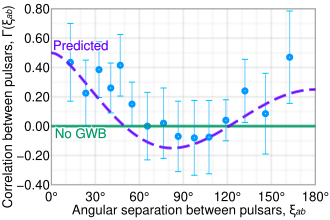North American Nanohertz Observatory for Gravitational Waves
The North American Nanohertz Observatory for Gravitational Waves (NANOGrav) is a consortium of astronomers[1] who share a common goal of detecting gravitational waves via regular observations of an ensemble of millisecond pulsars using the Green Bank Telescope, Arecibo Observatory, the Very Large Array, and the Canadian Hydrogen Intensity Mapping Experiment (CHIME).
Gravitational waves are an important prediction from Einstein's general theory of relativity and result from the bulk motion of matter, fluctuations during the early universe, and the dynamics of space-time itself.
They act as highly accurate clocks with a wealth of physical applications ranging from celestial mechanics, neutron star seismology, tests of strong-field gravity, and Galactic astronomy.
Hellings and Downs[6] extended this idea in 1983 to an array of pulsars and found that a stochastic background of gravitational waves would produce a correlated signal for different angular separations on the sky, now known as the Hellings–Downs curve.
The 2013 Demorest et al.[9] paper describes the five-year data release, analysis, and first NANOGrav limit on the stochastic gravitational wave background.
